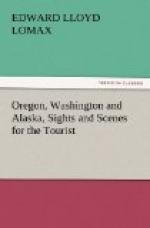The squaws, if they were in mourning or in love, would have their faces painted black with oil and tar. Then again, a great many wear a wooden or ivory pin thrust through the lip just below the fleshy part. It is worn for ornament, the same as ear-rings or nose-rings, and is called a labret. The missionary work done among them is a commendable one, but it seems a hopeless task. Their houses are always built with one object in view, to be able to tie the canoe to the front door. A long row of huts just above high-tide line can always be safely called a rancherie in that country. Their food is brought by the tide to their very doors, and the timbered mountains abound in wild game, and offer ample fuel for the cutting.
Chilcot, or Pyramid Harbor, is about twelve hours run from Juneau, and it is here the famous Chilcot blanket is made from the goat’s wool, woven by hand, and dyed by native dyes, and worked from grotesque patterns. Here, also, are two of the largest salmon canneries in Alaska, and here, indeed, were we in the
Land of the midnight sun.
The hours passed quickly by as the supposed night wore away. At midnight the twilight was so bright that one could read a newspaper easily. Then the moon shone in the clear sky with all regal splendor until 3.30 in the morning, when old Sol again put in his claims for admission. He lifted his golden head above the snowy peaks, and spirited away the uncertain light of unfolding dawn by drawing the curtains of the purpling east, and sending floods of radiance upon the entire world. It was a sight never to be forgotten, if seen but once in a lifetime.
Onward once again when the tide was in, and our next awakening was on the grand glacier fields. The greatest sight of the entire trip, or of any other in America, now opened out before many eager eyes. For several days, icebergs had been seen sailing along on the smooth surface from the great glaciers, and speeding to the southern seas like phantom ships. As the ship neared the bay, these huge bergs increased in size and number, with such grotesque and weird shapes, that the mind is absorbed in shaping turrets, ghosts, goblins, and the like, each moment developing more and more of things unearthly, until the heart and eyes seem bursting with the strain, when suddenly a great roar, like the shock of an explosion of giant powder, turns the eyes to the parent glacier to see the birth of these unnatural forms. They break from the icy wall with a stupendous crash, and fall into the water with such force as to send our great ship careening on her side when the swell from the disturbed waters strikes her.
The Muir glacier is the one that occupies the most attention, as it is the most accessible to tourists. It rises to a perpendicular height of 350 feet, and stretches across the entire head of the Glacier Bay, which is estimated from three to five miles in width. The Muir and Davidson glaciers are two arms of that great Ice field extending more than 400 miles in length, covering more area




